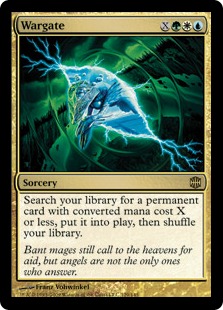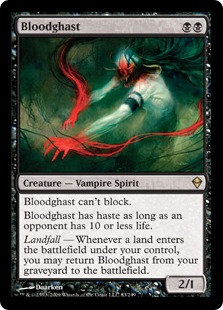Before I was a big-shot writer for the best Magic website on the planet, I was writing for my little hole-in-the-wall blog and shaping the thinking of
Magic finance writers everywhere. The basis of my “I don’t believe in rares” article has
become gospel in the MTG Finance community. Last week, we saw Stoneforge Mystic become the big poppa of all Standard rares. This naturally raises a lot
of questions for people, and if we dig deeper into the concept of the “I don’t believe in rares” article, then we can answer some of these questions.
Let’s look at an excerpt from my early days:
“The rare is dead. In order for a rare to break ten dollars, it has to be wildly popular, like Maelstrom Pulse, which is the bread and butter of Jund,
or it has to see consistent cross-format play, like Knight of the Reliquary and Noble Hierarch.”
Now, let’s fast forward to today. What rares are above $10 right now?
Stoneforge Mystic
The Zendikar Fetchlands
Inkmoth Nexus
Honorable mention goes to Green Sun’s Zenith, which is $9.99 on Star City Games, not quite $10 but almost. As you can see, there aren’t many Standard
rares that break the $10 mark. The rares that do bolster the $10-plus price tag have the same attributes that I talked about in the excerpt (with the
exception of Inkmoth Nexus, which we will get to).
Stoneforge Mystic
has what it takes to be a marquee rare. It’s popular in Standard, seven of the Top 8 decks from Paris were running it, and it has strong cross-format
playability. It’s been played in many Legacy decks, including Junk and Taxes, which Top 8ed the SCG Indianapolis
Open.
The Zendikar Fetchlands
are universal staples in every format. The only reason that they aren’t higher is because Zendikar was one of the most opened sets in the history of
Magic; that tends to happen when Wizards of the Coast sticks Power Nine in the packs. It’s easy to see why these are above $10, but despite them being
the cornerstone of many mana bases, they still barely break the $10 mark.
Inkmoth Nexus
is above $10 because the set hasn’t had time to settle into its true pricing. Inkmoth Nexus is a good card, but the jury is still out, and we haven’t
seen any cross-format playability. If it sees play in Legacy, then you can expect this to hold its value. If it doesn’t break into Legacy or Extended,
then I expect this to drop to the $5-$7 range.
Green Sun’s Zenith
, in case you haven’t got the memo, this card is really good. We’re only beginning to see its potential in the Valakut ramp deck in Standard. I expect
this to see play in combo Eves deck in Extended. Who wouldn’t pay two mana for a Heritage Druid out of their deck? At the SCG Open in Indy, I heard
murmurings of this seeing play in Legacy. I even played against a Zoo deck that used one to rip a Wild Nacatl out of the ether.
For a rare to breach this $10 barrier and become an Elite Rare, certain characteristics have to be there. I alluded to these things in the excerpt, but
now we’re going to explore them more deeply.
I. Cross-Format Playability
The more formats that a card is playable in, the more demand there is for the card, obviously, but the demand for cross-format cards is interesting
because, once someone acquires a cross-format card, they’re not as likely to put it back on the market, as they are with a rare that sees play in only
one format.
Here’s an example. I was recently cleaning out my play stock. The goal was to take all the Lorwyn and Shadowmoor block rares out and transfer them to
my trade binder (you should do this if you haven’t, by the way). I take note of the cards that I take out of my play stock (to trade or sell) and the
cards that I keep. You’ll see that I ship the cards that are played in only one format and keep the ones that have cross-format playability.
Cards That I’m Shipping
Here are some of the cards that I took out of my play-stock binder. Take note that I shipped cards that are narrow in application, like Wargate and
Prismatic Omen.
Wargate
— Wait! That’s not a Lorwyn-block rare! It’s not, but Prismatic Omen is. These rares are Extended-only rares at the moment, which means that Extended
drives the demand for them.
Prismatic Omen
— Even though I’m shipping mine, keep an eye on Prismatic Omen. My buddy Jaco has a sick Prismatic Omen/Scapeshift deck in Legacy. Â
Murmuring Bosk
— This is barely seeing play at all in Extended anyway. After the rotation, it will be near worthless.
Demigod of Revenge
— No Legacy love for this guy. Though, my friend Eugene did put them in his Legacy mono-black deck to metagame against me and my Landstill deck one
time. Outside of that incident, this guy won’t see much Legacy play, so it’s good to ship them now while all the Extended Jund players are going gaga
for them.
Reflecting Pool
— This card is falling out of favor fast. Only the diehards like Patrick Chapin are still playing X-Color Control in Extended. I’m hoping to ship these
ASAP.
Cards That I’m Keeping
These are a couple examples of cards that I’m keeping.
Knight of the Reliquary
— This card was very strong in Standard and continues to be strong in Extended. It still has another season in Extended and has become a Legacy staple.
In its prime, when it was seeing play in Standard, Extended, and Legacy, it was close to $20.
Noble Hierarch
— This card is a lynchpin in the Natural Order deck in Legacy, and it’s also a staple in the current Mythic Conscription build in Extended.
Maelstrom Pulse
— This has been seeing more play in Legacy lately; there are three copies in the sideboard of the hot new Junk and Taxes list. It also remains a
mainstay in the current Extended Jund lists.
Did you notice that I didn’t take out the cross-format cards, like Knight of the Reliquary and Noble Hierarch? The average player does the same thing.
They don’t want to have to find the card if they want to play it in Legacy or Extended, so when it rotates out of Standard, they keep it (as I did).
This lowers the supply available to meet the demand.
II. Scalability
This is a characteristic that I use to evaluate cards when I’m deciding if they could be an Elite Rare. Scalability is basically the measure of the
card’s ability to grow with the changing environment and metagame. Let me give you an example. Look at Knight of the Reliquary’s ability. This ability
works well with existing lands, but the important thing here is that Knight’s ability gets better with every new land that they print. That makes
Knight of the Reliquary scalable.
Another example of this is Stoneforge Mystic; it gets better with each new equipment that gets printed. When Sword of Feast and Famine got printed, it
met a very specific need in the U/W Control deck, and it helped drive the price of Stoneforge Mystic up.
III. Mana Cost
One of the first things that I noticed about playing Eternal formats is that most things don’t cost more than three. There are always exceptions; just
look at the second-place deck from the StarCityGames.com Legacy
Open in Indy last month, but for the most part, cards that have a low mana cost have a better chance of making it as an Elite Rare. Look at Cruel
Ultimatum; that card was awesome in Standard, but it now barely sees play in Extended and doesn’t see any play in Legacy.
Cards To Watch
All right, now you know what to look for in a rare to decide if it could be an Elite Rare. Let’s look a list of cards that I think have the potential
to be an Elite Rare like Stoneforge Mystic. I’ve separated this list into two sections. Shoe-Ins and Long Shots, Shoe-Ins are cards that I consider
Elite Rares in-the-making, and Long Shots are cards that in the right circumstance could rise to be elite, but they currently have something working
against them.
Shoe-Ins
Bloodghast
Fauna Shaman
Goblin Guide
Ratchet Bomb
Long Shots
Coralhelm Commander
Etched Champion
Kuldotha Forgemaster
Leonin Arbiter
Leyline of Sanctity
Lodestone Golem
Myr Battlesphere
Necrotic Ooze
Pyromancer Ascension
Take some time to think about these cards in the context of the three things to look for. Before I take off for the week, I’ll give you one more piece
of perspective in regard to Elite Rares.
Elite Rare Lifecycle
We have been describing an Elite Rare as a Standard rare that breaks $10. This method of thinking is great for cards that are in Standard, but once
they rotate, the concept of an Elite Rare gets complicated. Is Knight of the Reliquary an Elite Rare? An easy way to answer this question is this, what
would you rather have in your trade binder, a Knight of the Reliquary or a Stoneforge Mystic? Or a fetchland? You’d obviously want the card that’s most
relevant to the most people.
However, Knight of the Reliquary is still a solid investment, and it still has the characteristics of an Elite Rare. The only issue that it has is that
it’s not in Standard anymore. To deal with these kinds of situations, I developed the “Elite Rare Lifecycle,” which allows us to call Knight of the
Reliquary an Elite Rare but then classify it by the stage that it’s in. Here are the six phases in an Elite Rare’s lifecycle.
1) Release — The card is released, and the opinions on it vary.
Price Range:
$1-$10
Example:
Green Sun’s Zenith
2) Standard Notoriety — The card gains popularity over the next few sets while in Standard. (Think Knight of the Reliquary, which didn’t see its
price spike until fetchlands hit the scene.)
Price Range:
$3-$10 Plus
Example:
Mirran Crusader
3) Cross-Format Presence — The card starts to see play outside of Standard, while also being popular in Standard.
Price Range:
$6-$10 Plus
Example:
Ratchet Bomb
4) Rotation from Standard: The card rotates out of Standard but continues to see play in other formats. This is where spikes due to Extended
season and GPs really make it impossible to give the card a ceiling; see Thoughtseize before GP Atlanta.
Price
Range
: $8 Plus
Example:
Knight of the Reliquary
5) Rotation to Eternal: The card rotates out of other Constructed formats into Legacy and Vintage.
Price Range:
Changes with the meta of Legacy and Vintage. Typically, cards in this category go down in price until they’re immortalized as a staple.
Example:
Life from the Loam
6) Eternal Staple: The card becomes an Eternal staple. Eternal staples are always solid pick-ups.
Price Range:
$10 Plus
Example:
Crucible of Words, Natural Order
So, if you wanted to rate a card like Arcbound Ravager, it would be a Phase 6 Elite Rare.
Quick Hits
All right, that’s it for this week; here are some quickies to help you keep in tune with the market.
Goblin Guide
— This card is going down in price because one of the Event Decks has two in it. Goblin Guide was just about to break the $10 threshold, but now it’s
been on the steady decline. I expect them to even out at $5- $6.
Foil Blightsteel Colossus
— These were $60 after the release of MBS. They have now fallen to $30 on eBay.
Karakas
— This card is on the rise again. They’re sold out at StarCityGames.com, and you can’t get them cheaper than $45 elsewhere.
Thanks for reading.



